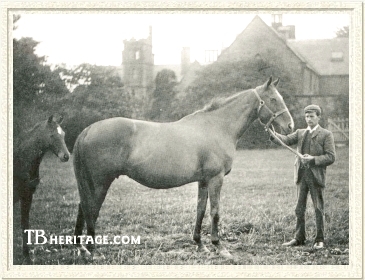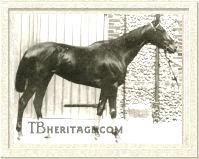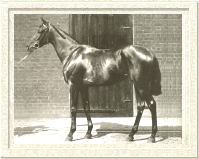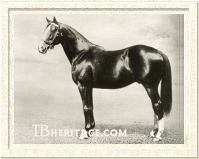|
|
St. Marguerite

|
|
 |
|
|
St. Marguerite was the epitome of the "classic" Thoroughbred, from her lineage, to her racetrack performance, to her legacy in the breeding shed. She was bred to be a high class filly, being by a Derby winner and out of a stakes-winning daughter of a classic winner and leading sire. As a producer, she proved highly influential, founding a family which not only produced English and American Triple Crown winners, but a family so strong that classic winners are still emerging from it more than a century after her passing.
St. Marguerite was a chestnut filly foaled in 1879. She was bred by William Stirling Crawfurd, a man who had enjoyed considerable success as a breeder and owner, having owned classic winners Mayonaise, Moslem, Gang Forward, and Craig Millar. In 1879, Crawfurd married the colorful and eccentric widow of the fourth Duke of Montrose, the former Caroline Agnes Beresford. Together, the husband and wife team would enjoy even more success, and owed much of it to the offspring of their mare Devotion.
Bred by Mr. Haig, Devotion was a daughter of Stockwell out of the Touchstone mare Alcestis. Devotion traced in the direct female line to 1814 Oaks victress Medora, dam of fifteen foals, including Oaks winner Gulnare. Though she died on passage to Germany at the age of 24 in the autumn of 1835, Medora left behind in Britain a family which would produce over the next several generations Two Thousand Guineas winner The Corsair, One Thousand Guineas winner The Flea, and One Thousand Guineas winner Virago.
Devotion was a good performer on the racetrack, winning six races, including the Chichester Stakes at Goodwood. As a broodmare for William Stirling Crawfurd and his wife, the Duchess Caroline, Devotion proved a marvel, especially when mated to Hermit. This union produced six stakes winners. Thebais, the eldest of this sextet of siblings, was foaled in 1878. She was a winner of more than 25 races, including the One Thousand Guineas, Oaks, Yorkshire Oaks, and Ascot Gold Vase. Later came Clairvaux, winner of the Fern Hill Stakes and July Cup; Heloise, winner of the Coronation Stakes; Grand Prior, a winner of the Ascot Triennial Stakes; multiple stakes winner and classic-placed filly Adoration; and, the subject of this essay, St. Marguerite, one year younger than Thebais.
At the time Devotion was first sent to be covered by Hermit, the diminutive chestnut stallion was rapidly becoming one of the more popular sires in England. He was a son of St. Leger winner and five time leading sire Newminster. As a member of the racing stable of Henry (later Viscount) Chaplin, Hermit captured the Epsom Derby of 1867 and placed second to the brilliant Stockwell filly Achievement in both the St. Leger and Doncaster Cup. By 1880, when St. Marguerite was a yearling, Hermit was sitting atop the British general sire list and would remain there for another six years. By mating her to Hermit, the foals of Devotion carried a 3x3 inbreeding to Touchstone. In addition, Hermit was out of a Tadmore mare. Tadmore was sired by Ion, whose dam was a daughter of the aforementioned Medora. Thus, St. Marguerite and her siblings carried a 5x5 inbreeding to Medora's daughters, the half-sisters Pucelle and Margaret.
Though Duchess Caroline seemingly dominated the turf affairs of her husband William Stirling Crawfurd, it was he who was listed as the owner of record for Thebais and St. Marguerite when they gained their classic triumphs. Not nearly as overwhelmingly superior to her rivals as Thebais had been, St. Marguerite was clearly a high class individual, and had to be, for she was a member of an exceptionally strong crop of fillies foaled in 1879. In that crop were Shotover (another daughter of Hermit), Geheimniss, and Dutch Oven. Between them, these four fillies would completely dominate the classic races of 1882.
St. Marguerite on the Turf
At two, St. Marguerite took the Chesterfield Stakes, the Bretby Stakes, and the Home-bred Foal Post Stakes, all at Newmarket. In the July Stakes, also at Newmarket, St. Marguerite dead-heated for third place with Dutch Oven as the race was won by the brilliant Cremorne filly Kermesse. St. Marguerite and Kermesse were in a dead-heat for second, only a head behind Dutch Oven, in a race run at Goodwood. In the prestigious Middle Park Plate, St. Marguerite was no match for Kermesse, finishing well back from that rival in a field which also included Shotover.
At three, St. Marguerite captured the One Thousand Guineas. Shotover, fresh off a victory over males in the Two Thousand Guineas, was second, beaten only a neck. Nellie, yet another daughter of Hermit, was third. Shotover went on to defeat colts in the Derby, bypassing the Oaks. In the Oaks, St. Marguerite finished second to the late-developing Geheimniss, a daughter of Rosicrucian who had been only a minor stakes winner as a juvenile. At Goodwood, St. Marguerite captured the Nassau Stakes. All told, during her career, St. Marguerite won six stakes, including a walk-over for the Municipal Stakes.
St. Marguerite in the Stud
Each of this extraordinary group of mares -- St. Marguerite, Shotover, Kermesse, and Geheimniss -- became significant broodmares. Shotover became the dam of major winner Orion, but is remembered as the ancestress of foundation mare Frizette. Kermesse became the dam of Montem, a winner at two of the New Stakes and July Stakes and ancestress of Colombo and Midas. Geheimniss founded a family which over the years would produce major sires Pilate, Lemonora, and Prince John, as well as American champion filly Lamb Chop. However, it was St. Marguerite who enjoyed the most successful broodmare career, as she became a classic producer and the matriarch of a family which would come to produce classic winners in England, Germany, France, and the United States.
For her first mating, owner William Stirling Crawfurd chose to send St. Marguerite to his Derby winner Sefton. The result, foaled in 1884, was a filly named ESTEREL. Being a daughter of two classic winners would seemingly make this filly special right from the start, but sadly, she amounted to nothing. She made no mark on the racecourse and was later sent to Germany.
In 1885, St. Marguerite delivered the first of six consecutive foals by Isonomy. A diminutive son of Sterling, Isonomy won the Derby in 1878 and at four and five, became one of the finest cup performers ever seen in Britain, accounting for two runnings of the Ascot Gold Cup, as well as the Doncaster, Goodwood, and Manchester Cups. He was purchased by William Stirling Crawfurd and his wife, the Duchess of Montrose, at the dispersal of Frederick Gretton's horses at the Tattersalls sale of January, 1883. The next year, 1884, Isonomy was installed at the Duchess of Montrose's new stud, Sefton Stud, near Newmarket; Crawfurd died not long after.
|

Seabreeze
| |
The 1885 produce of St. Marguerite and Isonomy was a handsome chestnut filly which was given the name SEABREEZE. William Stirling Crawfurd and the Duchess of Montrose did not race Seabreeze. Duchess Caroline sold Seabreeze as a yearling to Captain Machell, as part of a lot Machell bought sight unseen for £9,000. A little more than a week later, Machell resold all of them to Lord Calthorpe, who entrusted Seabreeze's training to James Jewitt, the man who had conditioned Isonomy. The story goes that the Duchess repented of the sale, and hoped to purchase them back, but upon inquiring into the possibility, was informed that Lord Calthorpe's horses had been moved to their regular training headquarters.
|
At two, Seabreeze racked up victories in five stakes. Her wins came in the Ham Stakes at Goodwood, the Biennial Stakes at Ascot, and the Buckenham Stakes, Triennial Stakes, and Boscawen Stakes, all at Newmarket. In both the New Stakes at Ascot and the July Stakes at Newmarket, she ran game seconds to the speedy Hermit colt Friar's Balsam.
She was even better at three. After finishing second in the One Thousand Guineas to the Springfield filly Briar-root, Seabreeze went on to take the Oaks, the Coronation Stakes at Ascot, the St. Leger, and the Lancashire Plate. In the St. Leger, Derby winner Ayrshire was unplaced, and in the Lancashire Plate, Ayrshire ran second with Friar's Balsam unplaced. As a broodmare, Seabreeze was something of a disappointment. She did produce two stakes winners, the full brothers Admiral Breeze and Tom Cringle, both by Donovan. The former was a winner of the Doncaster Stakes, the latter a winner of the Ascot Stakes. Seabreeze failed to produce a daughter capable of carrying her branch of St. Marguerite's family forward.
1886 saw the arrival of another chestnut daughter of Isonomy and St. Marguerite. This was ANTIBES. Duchess Caroline did not make the same mistake twice. This filly she retained. Though not of the classic calibre of her elder sister, Antibes was nevertheless a high class performer, winning six races. Her victories included the Midsummer Plate, the Knowsley Dinner Stakes, the Zegland Stakes, and the Yorkshire Oaks. In the latter event, Antibes defeated Minthe, heroine of that season's One Thousand Guineas.
At stud, Antibes failed to produce anything of high class. Her family produced a number of stakes winners, the most notable being By George, winner of the Imperial Produce Stakes and broodmare sire of Derby winner Windsor Lad.
St. Marguerite's next foal, also a filly, was the bay RIVIERA, foaled in 1887. As a two-year-old, Riviera was brilliant, winning ten races, including the Windsor Castle Stakes, Hurstbourne Stakes, Ham Stakes, the Rous Memorial at both Goodwood and Newmarket, and the Champagne Stakes at Doncaster. Only the Duke of Portland's tiny St. Simon filly Semolina had a better record, capturing thirteen of her fifteen starts. Tragically, Riviera died unexpectedly as a three-year-old in 1890.
In 1888 came St. Marguerite's first colt, VALAURIS. Despite his illustrious parentage, he made no mark on the racecourse and was a disappointing sire. He was followed in 1889 by another Isonomy filly, HYERES. At age two, she ran unplaced in each of her four starts. At three, she was a bit better, winning the Visitor's Plate at Newmarket and placing twice in eleven starts.
Hyeres wound up in Germany, where she became an important producer. Her son Hagen captured the Deutsches Derby and the Preis der Winterfavoriten, and her daughter Hut-ab was victorious in the Preis der Diana. Hut-ab in turn produced Hochzeit, who emulated her mother by taking the Preis der Diana. Another daughter of Hyeres, the Matchbox filly Hutschachtel, captured the Grosser Preis von Hamburg.
In 1890, St. Marguerite came up barren to Isonomy for the first time, and in 1891 produced a dead filly by him. Her last Isonomy offspring arrived in 1892, the bay colt LE VAR. Sold to Sir Frederick Johnstone, Le Var finished unplaced to Sir Visto in the 1895 Epsom Derby, then reversed the form by beating the Derby winner in the Princess of Wales's Stakes at the Newmarket July meeting. Le Var broke down in the Eclipse Stakes won by Le Justicier shortly thereafter. He was not a successful sire.
Le Var was from Isonomy's last crop, the old stallion passing away in the spring of 1891. Duchess Caroline then decided on a different cross for St. Marguerite, and accordingly, sent her mare to the Duke of Portland's Welbeck Abbey Stud to be covered by St. Simon. The result, born in the spring of 1893, was a brown filly given the name ROQUEBRUNE. Duchess Caroline died in 1894, leaving a son from her first marriage who did not wish to deal with her horses. Her bloodstock was sold, Roquebrune going to Sir James Miller. |

Roquebrune
| |
Roquebrune's only win was the New Stakes at Royal Ascot as a juvenile. She was better as a broodmare, for she produced English Triple Crown champion Rock Sand, as well as stakes winner Roquelaure. A daughter of Roquebrune, Roquette, became the dam of Dagor, a Flying Fox colt who became a champion in France and a winner of the Prix du Jockey Club. A full sister to Dagor, the mare Dagora, founded her own branch of St. Marguerite's family which included the Swedish stallions Temible and Danger, and Blue Tzar, winner of the important Prix de la Salamandre. Hesperia, another daughter of Roquette, founded a German branch of the family, which over the years was responsible for several good performers, most notably the filly Bella Paola. Bred in France, but of predominantly German blood, Bella Paola captured the English One Thousand Guineas and Oaks in 1958. |
St. Marguerite gave birth to dead twins by St. Simon in 1894. She was purchased for 2,000 guineas in the dispersal of the Duchess Caroline's bloodstock by Major James E. Platt. For that gentleman, St. Marguerite foaled the filly ST. MARINA (shown as a filly in photo above), by Isonomy's son Janissary, in 1895. St. Marina never raced, but her unraced daughter Seraph, by St. Frusquin, produced six winners, including the Radium filly Fairy Ray. This filly was eventually sold to American breeder Arthur Hancock of Paris, Kentucky. He bred her to the Domino line stallion Celt to get the filly Marguerite, purchased by William Woodward and raced once. As a broodmare Marguerite produced the high class handicapper Petee-Wrack (by Wrack); U.S. Triple Crown winner Gallant Fox and his brothers Fighting Fox (Futurity, Wood Memorial, and others) and Foxbrough (winner in England of the Middle Park Stakes). A daughter of Marguerite's, the unraced Marguery, was second dam of the tough race mare and outstanding producer Margarethen (by Tulyar), later dam of Trillion, the champion older mare in France and champion grass mare in the U.S., who in turn produced Triptych (by Riverman), champion in England, Ireland and France. Other horses descending from Margarethan's line include Poule d'Essai des Poulains winner Landseer, Epsom and Irish Derby winer Generous, and Epsom Oaks and Irish One Thousand Guineas winner Imagine (by Sadler's Wells). 2005 European champion juvenile Horatio Nelson (by Danehill) is out of Imagine.
St. Marguerite had three more foals after St. Marina. SWEET MARJORIE, by Kendal, foaled in 1896; GALLERTE, a colt by Isinglass, foaled in 1897; and the colt TREDENNIS, by Kendal, foaled in 1898. Sweet Marjorie was a minor stakes winner, capturing the St. George Stakes and the Durham County Produce Stakes. Among her placings, she ran second in the Park Hill Stakes at Doncaster and third in the Limekiln Stakes at Newmarket. She produced only minor winners and her extended female family yielded few major winners with the exception of Warden of the Marches, winner of the Champion Stakes and City and Suburban Handicap, and Dick Turpin, winner of the Chester Cup. Gallerte was not distinguished on the racecourse or at stud. |

Tredennis
| |
St. Marguerite's final foal was TREDENNIS. By the Bend Or stallion Kendal, he lost his dam the day after he was foaled, and was raised by a cart mare. He was sold at Doncaster as a yearling, purchased by Captain Machell for 2,000 guineas, a bid Machell had put in as a starter, fully expecting the price to rise. Although a small foal, Tredennis grew to just under 16 hands, and was described as having "beautiful quality," with "very nice action but no dash." He was "inclined to be cheeky," and after breaking he was turned out until his three year old year. When he finally got to the race course, he proved to be a very slow horse, and ran unplaced in his two races that season. At age four he was unplaced again in his only race, a handicap over 12 furlongs, and ten days later Machell died. Put in Newmarket's July sales, he was sold for 100 guineas to Charles Pulley, who sold him a few months later to Albert Lowry of Oatlands Stud and Bachelor's Lodge, Co. Meath, Ireland for £100. |
Tredennis started his stud career at a fee of £5. He got few mares at first, most belonging to Lowry and his father. In his third crop of 1906 he got Bachelor's Double, winner of the Irish Derby and eight other races, and a good stallion in his own right, with Prix de l'Arc de Triomphe winner Comrade and English Oaks victress Love In Idleness to his credit. Bachelor's Double was an outstanding broodmare sire, his daughters producing Ascot Gold Cup winner Precipitation; Coronation Cup winner Persian Gulf; St. Leger winner Scottish Union; English Oaks winner Lovely Rosa; Derby winner Call Boy; One Thousand Guineas victress Pillion; Prix du Jockey Club winner Duplex; and further top class performers Fiterari, Double Arch, Fourth Hand, Superbe, and Casanova.
Tredennis did not rest his laurels on Bachelor's Double alone, and at his height his stud fee ran up to 200 guineas. He was also responsible for Ascot Gold Cup winner Golden Myth; Doncaster Cup winner Pons Asinorum; Irish Derby winner Bachelor's Wedding; the gelded Hornet's Beauty, a champion sprinter in England that won 31 races; and Soldennis, winner of the Irish Two Thousand Guineas. The latter also made a fine stallion, siring Denis Boy, winner in Australia of the Caulfield Cup; Soloptic, victress in the Irish One Thousand Guineas and Irish Oaks; and Sol de Terre, winner of the Irish St. Leger.
In 1922, with Golden Myth running, Tredennis was fifth on the sire's list in England. Many of his offsrping were tough and long-running, including Soldennis, who won 24 races, and Hornet's Beauty. Of his daughters, Wet Kiss, winner of three races, was the best producer; her son, Derby and St. Leger winner Coronach (1923) sent Tredennis to the top of the broodmare sire list in England in 1926. Tredennis died after a year of infertility and several weeks of illness in 1926, the year of Coronach's great triumphs.
St. Marguerite died in 1898, a day after the birth of Tredennis. She was 19-years-old, and during fifteen seasons has been barren just once. With descendants like Triple Crown champions Rock Sand and Gallant Fox, no one could have asked for much more.
--Liz Martiniak
|
|
|
|

